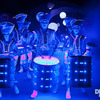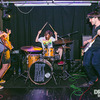Welcome to the latest artwork feature, dedicated to the art of art, and the art of music. Jon Falcone looks at upcoming releases from the next two months that marry an excellence of sound with a love of a tactile product. Be they strange, beautiful or interesting, each release offers something worthwhile to stuff in your hands, as well as your ears. Consider it a coffee table book for your Smartphone.
M+A, ‘These Days’ (Monotreme Records)
Monotreme Records has recently celebrated 10 years of independent, excellent, leftfield releases. An Italian duo, M+A’s second album is a slice of electronic lounge pop beaming with La Dolce Vita. At first this could be construed as achingly hip, but inside its Brooklyn indie-dance wrapping is a series of heartfelt, affecting pop songs. Alessandro Degli Angioli is not only a writer and performer in the duo but also designed the band’s album artwork and merchandise. We posed him some questions on his featured kaleidoscope of colour.
DiS: As a designer and musician you can rightfully claim to be a Renaissance man. Where did your love for the arts stem from?
ADA: Currently I’m doing a MA in Visual Communication in Bergen, Norway, at KHIB. I’m in my second year so I’m going to spend the next year there too. Before this MA, I’ve attended ISIA at Urbino, an Italian school mainly focused on editorial design.
Graphics and music has always just been my thing, in a way they’re two worlds running parallel to me. One influences the other and vice-versa. I’ve always tried to mix them up, applying graphic “rules” to music and music “rules” to my graphics, it has always led to interesting outcomes. Through the years I got to realize how some dynamics that are already established in music still struggle to emerge in the graphic field and the same with certain graphic styles into music. Having the chance to experience both of these realities allows me to have a more detached view on what I do and, most of all, it helps me oxidize my projects with new inputs. When I spend too much time on music, graphics helps me take a little break from it.
DiS: Where did the idea for the artwork come from, from your merchandise designs I can see you like birds, what do you like so much about birds?
ADA: Well let’s clarify in that I’m not really into birds straight away. The artwork of this album is centered on feathers as an exotic component. Therefore I’ve created a texture of parrots in order to use it on the t-shirts. What you can see here are the t-shirts I’ve hand printed at my school lab. I used to make just the graphics before, but now that I get the chance to screen print them myself I’ve come to realize how much you can experiment in the printing stage as well. These were the first tries, just to practice. I think I’m getting new ones done soon.
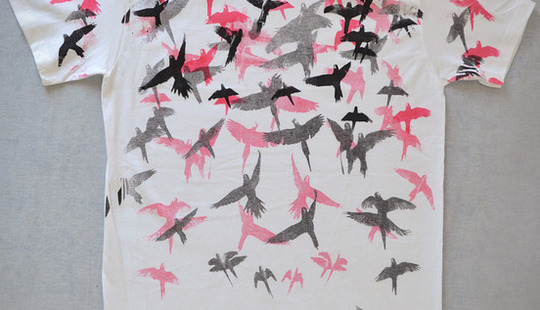
Merchandise has always been really important for M+A. It’s our mean to broaden the realms of our imagination. Sometimes you can’t say everything with music, or to phrase it positively better, sometimes it is easier to get things across with other media. So the artworks, the t-shirts and the posters we make are an extension of our music and ourselves. The realm of imagination created around us made us more recognizable and, considering how many people approach to our merchandise stand after our concerts, we feel like we’ve made it. At the same time we’ve chosen not to show our name M+A on the t-shirts, just because we don’t see them as a mere marketing item by which we make money, but rather as a second-side of M+A, almost as if it was a fashion brand totally that’s independent. We sell loads of t-shirts even to people who don’t really listen to our music or that never got to listen to it, which shows that it can stand up in its own way.
DiS: So looking now at the artwork, how did you capture these shots, and are there any effects added to the shots at all?
ADA: For the graphics of the album artwork and all the album covers I design, I’ve always started from photos taken by other, in this particular case I started with images by Juan Castillo.
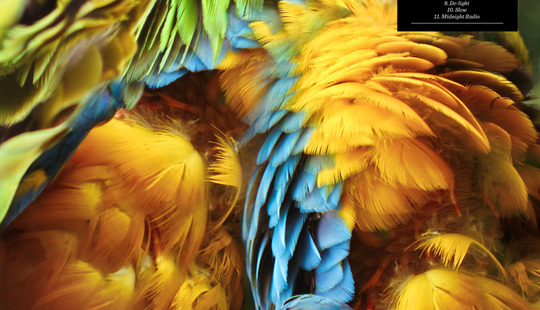
I worked a lot on the post-production; mixing, repeating and blending photos together, trying to create textures that look as much as possible like a reality, never getting them too abstract. I wanted the exotic colour of the feathers to be breathing, to try and make the image feel like more than just a photo.
DiS: The bird feathers also make me think of escaping to somewhere more exotic. Would you say this is an exotic image?
ADA: Exactly, the main reason why I chose to use the parrot feathers was create an exotic mood. While recording the album Michele (M+A) and I listened to a lot of South American and Bossanova music, which highly influenced us. I wanted this mood to be live in the graphics. At the same time I wanted the graphics to be very effective and direct and also wanted it to work well on great dimensions, as on a poster or vinyl.
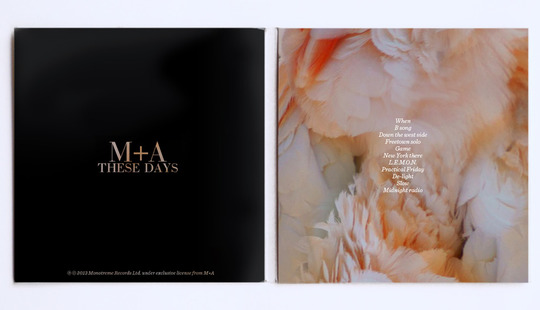
DiS: Is living the good life really as important as people say it is in Italy? Is the art work a reflection of the good life?
ADA: It depends a lot on what you mean when you say “good life”, but I don’t think the artwork has a lot to do with it. Actually, often times my graphic repertoire tends to represent what I’m missing and I don’t have. I’m not influenced by what’s around me but far more by what I don’t have. With my works I tend to recreate moods I’ve never really experienced. Maybe this is a direct way to get to have them. For instance, this sunny and coloured artwork has been made this winter while I was in Bergen. In that period, days used to have not more than three to four hours of light and outside it rained and snowed all day long.
DiS: With these Latin rhythms, this also feels like a current take on lounge music. It is rhythm focused without being 'dance' and is composed emotionally. Did the aesthetic of lounge music play any role in the design process?
ADA: During the past years I’ve listened to a lot of lounge music. It certainly has influenced both my music and my graphics and one of the biggest features of it for me is elegance. It has always been an essential component to be included everywhere. Managing to say something elegantly is a not an easy skill and, for me, it also represents my will to never take for granted the aesthetic side of things – even the tiniest details. I don’t believe aesthetics can matter more than contents, but I reckon it can deeply transform the perception that people get of that content.
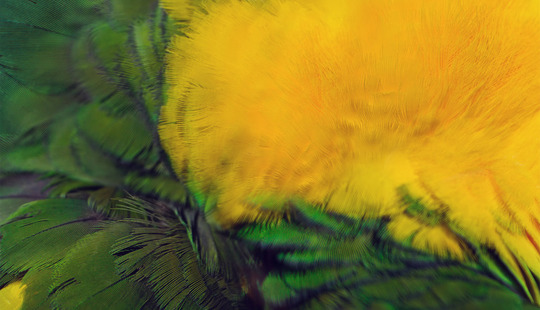
Succeeding at creating an image from imagination in which people recognize themselves is fundamental, just as fundamental as people recognizing themselves in music. As the history of rock or pop music teaches us, the ability of the musician does not only lie in making music but also in the way he offers it to the public. I think the biggest musicians succeed at becoming so big also because, directly or not directly, they’ve managed to recreate an aesthetic that people identify themselves with. But, there are people who are annoyed by this idea. I think, however, it’s the ABC of this field. A brilliant idea doesn’t exist if it can’t be expressed in the proper way.
DiS: When approaching this project, who were your influences and how did they feed into this the design?
ADA: I always try not to make heroes of people and most of all I always try to destroy my saints and my beliefs before it’s too late. I think I’m a person that artistically lives by chapters or stages. After spending quite a bit of time inside a genre I begin to get fed up and feel the urge to move towards completely opposite stuff. I make an effort to go against myself.
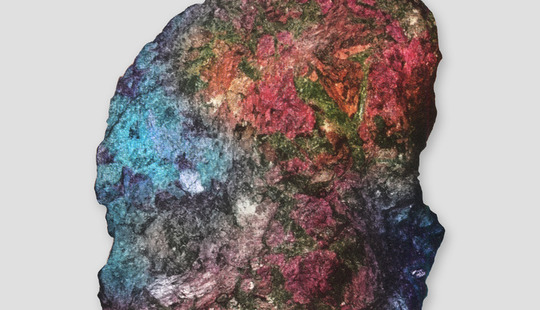
I have come to realize that artistically and graphic-wise I’m way more productive when I try to do something I’m not knowledgeable about, so I always tend to change before my style in a certain area might perfect itself. When I get aware of how I’m starting to make something come out too well I’ll leave it and begin with something different, where I’m forced to start right back from the beginning.
This makes each of my works a bit defective and “hasty”, but helps me stay alive. Both Michele and I are like that, and the new album shows it: we wanted to try to do something in a music genre we were not fully experienced for, neither technically nor mentally. This forced us to rack our brains more. Obviously, the product is never perfect and is a first experiment, but it keeps some sort of authenticity that people can perceive – even something more than the authenticity of imperfection.
DiS: The text on the cover also adds an air of sophistication to the image, can you tell me about the font and the decision on putting that text box on the cover.
ADA: The school I attended in Italy, ISIA, had a strong typographical heritage, very tied to ancient typography. I think it’s left within me some sort of peculiar attention to fonts. The reason why I’ve chosen to include the black rectangle is from my desire to add a sophisticated touch to the image. I didn’t want the cover to be a simple image, I wanted it be recognized as an album cover. The way you deal with the font or the text can really change the mood of an artwork.
The font I’ve used is Bodoni. It’s one of my favourites because it can impart a very subtle elegance. As many will know, it’s often used in fashion magazines. I like it how sometimes when I use this font for the name M+A it makes it look like the name of a brand. This is one of those cases of my graphic design studied adding an element of what could be considered compromise a musician.
‘These Day’s will be available from 30th September on CD and digital download and also as a deluxe 180-gram vinyl edition (300 copies on white vinyl with colour printed inner sleeve and a free album CD included inside).
The Thing, ‘Boot’, The Thing Records
The Thing are a renowned free jazz trio from Scandinavia, last year they released the critically acclaimed ‘The Cherry Thing’, a collaboration with Neneh Cherry and have collaborated widely with the likes of Sonic Youth, David Grubbs, The Ex and Merzbow across 600 concerts, five studio albums and numerous live recordings. Releasing their first album on their own label, The Thing Records, DiS caught up with album cover designer Lasse Marhaug on the next step in this band’s fine history and how his bold imagery fits into their cannon.
DiS: The Thing’s visual style has been consistent style across their output. Has your approach to this artwork been affected by the knowledge that the band are now self-releasing? Does it feel like more a personal creation?
LM: I wanted to create a cover that would fit well with the band's back catalogue. As they are now starting a label of their own I didn't want to have the cover be a radical departure or show a new direction. It needed to signal that the previous visual style was connected to the band, not the old label. At the same time I wanted something very simple and raw. A simple image that packs a punch.
DiS: Where did the idea for this bold cover come from? It compliments the style of their past releases but for also heads further toward the anarchist culture of Crass, The Ex, Flux of Pink Indians, what’s the story behind the image?
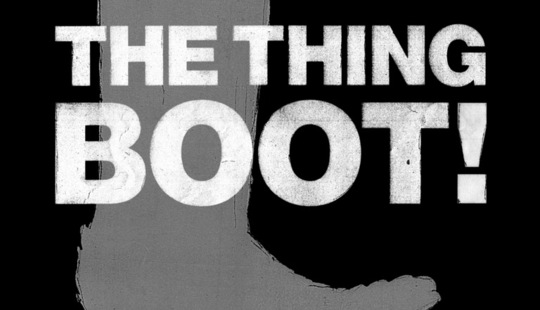
LM: The title of the album is ‘Boot’ The band are all fans of boots, especially the drummer, who wears stuff like crocodile and snakeskin boots. They are maniacs. I thought boots are visually nice and I first made a design that was simply that – just the silhouette of a boot with the band name and title over it. Visually it was a striking image, it had the simple energy I was looking for, but it was just too obvious. We all agreed to find something else. Then I looked at the band photos they sent me. It was a session of them fooling around. There were two photos that the band wanted for the back and inner cover, which I was fine with, but then there was also one of Paal and Ingebrigt flexing their muscles. When I zoomed in and framed Paal's muscle against the wall it looked really good. It's playing on the band's reputation as a physical and manly band, but blatantly using an image of a muscle also shows their sense of humour.
The reference to early Eighties punk and hardcore is correct. My first publications where crude underground fanzines in the early Nineties. I love the look of cut and paste. I work with computers, but want the design to look like it has been a round in the physical world as well.
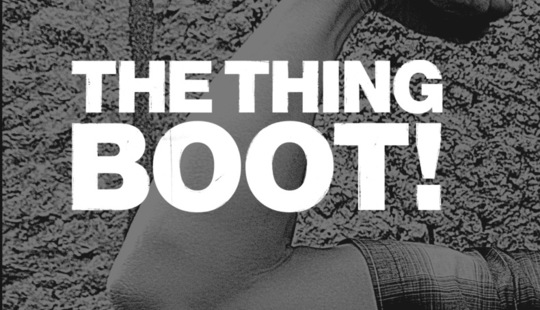
DiS: What it is about the contrast of black and white that you and the band like?
LM: Since I wanted to signal a continuity in the band's visual history I decided on using just a basic bold Helvetica, that same that was used on their previous covers. If it's not broken, why fix it? Too many designers think of themselves as artists and this can get distracting. The designer’s job is servicing the band and their music before their own name. I'm more of a craftsman than an artist.
To make the font look more organic I printed it with my cheap laser printer, and then roughened it up with a knife and ink, also curled it up, before I scanned it back into the computer. I sometimes do this with photos as well, but for this one I just increased the contrast in Photoshop.
I like high contrast black and white images. But for ‘Boot’ I felt it needed something more, so I added a Pantone silver base. It makes it a little bit classier and lets the white lettering come through more strong.
DiS: Who are your peers and influences in Scandinavia?
LM: There's many graphic designers in Norway that I respect: Halvor Bodin, Martin Kvamme, Kim Hiorthøy, Rune Mortensen, Grand People, Yokoland, Node, Kim + Trine, Anti, Petrie Points, This Way Design. All of them are doing really good work. But as a graphic designer for record covers I tend to look at designs from the Sixties and Seventies for inspiration. I'm a record collector and have a lot of respect for all the incredible work done in the past. I'm also influenced by a whole spectrum of filmmakers, illustrators and visual artists, but that's too much to go into here.
DiS: Is there any specific to Scandinavia geographically that inspires you?
LM: It's a good climate for music and visual arts, although I don't think it's any better than most of the countries I visit when I travel. Good ideas can be found everywhere.
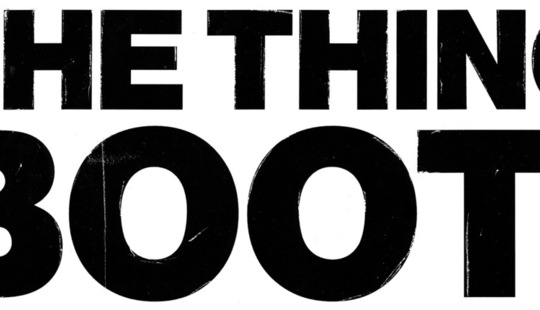
DiS: With The Thing often being cited as a punk/jazz crossover act, what do you think about the function and process of labeling music and its creators and do you think artwork plays a role in this process?
LM: I don't think The Thing is a punk band in other ways than their attitude. They are first and foremost a free-jazz power trio, but they are fuelled by a wide range of influences, from punk and rock to old jazz and avant-garde. You'd be surprised how much obscure underground noise craziness Paal and Mats have in their record collections.
‘Boot’ is available from 5th November on vinyl, CD and download from The Thing’s website.
The Pure Conjecture, ‘Gendres’, Armellodie Records
The Pure Conjecture’s center pin, Matt Eaton, has been softly been combining the orchestral flourishes of Burt Bacharach with his everyman attitude and an unhealthy obsession with Jonathan Richman (Matt plays in a tribute band, the Modern Ovens) for over a decade, initially in a band called Bryter Lunch, then in Brighton band Actress Hands and now in his soft rock troupe The Pure Conjecture, which includes members of Brighton stalwarts, British Sea Power and the Electric Soft Parade. Interestingly he released one of last year’s most genuinely overlooked albums, an opera for the Olympics, written and recorded in collaboration with Keith Allen (yes that Keith Allen). Matt now lives in Cardiff and continues to put out gems such as ‘Gendres’ (you won’t hear an album this year that manages to contrast the opener of ‘Roadworks On Memory Lane' with the lyrics “Nobody looks for me when I shop for clothes/And what I wear on Wednesdays, nobody cares” into a post-surf-guitar intstrumental, ‘Surfin’ Sunset’). DiS asked album sleeve designer Stuart Brett a few questions on the beauty of cut outs and neon.
DiS: Armellodie Records is one of those beautiful indie labels that realises music needs to be put out and made available, but without a commercial expectation. What was your route to the ‘Gendres’ album and Armellodie?
SB: I’m friends with Al Nero, from Armellodie Records, who signed the band. Al’s given me a few projects in the past including creating the label’s logo, artwork for Super Adventure Club’s second album and some singles. I’ve also worked on promo merchandise and label tour posters and flyer work. We get on well and I’m cheap, so that works well for the both of us.
I’m always honoured to work with other bands. When I was working on artwork for my old bands I was very protective and had a precise style I wanted for everything. So I know how much it means to the bands when they hand over the responsibility of creating what is put in your hands before you get to hear it.
DiS: So you came to music and design at the same time?
SB: Music slightly earlier. Music and visual art have been very influential. They led me to writing music and I suppose eventually working in the design industry. For me, visuals have always gone with music. I’d listen to a lot of Vangelis when I was little and I had all these little cinematic scenes or static images sparking off in my mind. I can’t listen to music without building some sort of scenery in my head. I’m sure everyone else is the same.
DiS: You paint quite an interesting scene for ‘Gendres’, you’ve some hot colour on show, yet the music is rich, subtle and restless. Is this cover a deception?
SB: The cover is a deception but not entirely. The band is quite mysterious in terms of the sound and their public persona, which only really exists in print, and I wanted to convey that. They’re made up of some exceptionally talented people that have come from some established bands but they’ve created something completely unique and also something that could be mistaken for being from another era.
There’s even vinyl noise on the track, ‘Dictators’. Without having any knowledge of the band, you could mistake it for being something from another time. So that was the first visual element I wanted to throw in.
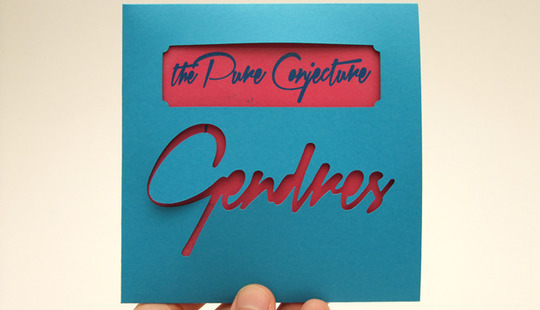
DiS: So did the band want an Eighties feel to the cover to sit alongside the Seventies styled compositions?
SB: Well, the guys wanted to use the image of the two girls, which was originally something they spotted in an old catalogue from the Eighties. The album name and the photo struck up an image in my head right away. I knew I wanted the artwork to emphasize the style of the photograph, so the ‘blue for boy, pink for girl’ theme came from that.
I created a style of writing that looks like a little personal note, or letter. I also wanted to make it look like the kind of record I would pick up in a record shop and wonder ‘what the fuck is this?’ Take it out the sleeve, scratch my head at the photograph, be intrigued and then pop it on… to be completely surprised and drawn in. That was my plan at least.

DiS: What’s the physical process in making a cut sleeve?
SB: The Sleeves are machine-cut by a manufacturer. Armellodie suggested having a look at the type of things they could do as we were going for a very limited edition run to begin with and that’s where it all came from. I had a frame work and that started it off. I wanted the girl/boy colours to slot into each other and to have parts that when looking at one colour you see another, so the blue has pink inside, just little playful sort of subtle things going on that could maybe, or maybe not, relate to the picture of the two girls. I kept going back to this little puzzle idea, keeping the music on one level and having sleeve art that has its own dialogue with the listener.
DiS: As an experienced graphic designer, what for you makes good design and what elements of the ‘Gendres’ sleeve adhere to these principles?
SB: I do a lot of illustration work, logo design and things like that but record sleeve art is my first love. I’m not a fan of album sleeves that just spell out a band and who they are. I like something that can at first seem at odds, but then makes sense to you after you listen to it.
Joy Division’s ‘Unknown Pleasures’ was a favourite as a kid, as was Sonic Youth’s ‘Daydream Nation’. They’re very unique and have their own dialogue going on while you hold the sleeve and listen to the music. Something you rarely get these days with the reduced amount of physical media in the world. If I’m able to, I’ll try and put that into every sleeve design. There’s no point in bringing in a guy like me if you want something that just has a band name and a photo of a moody bunch of lads hanging around a fire escape.
‘Gendres’ is available from 7th Octoberon limited edition CD with instant download.
Fuzz, ‘Fuzz’, In The Red Records
Fuzz is a sludge rock trio with the ever-candescent Ty Segall on vocals and drums. It’s a wonderful journey through the power of the guitar, with many tangents thrown in for good measure. A mention of heavy metal unsurprisingly evokes imaged of armour, knights and dragons and Fuzz’s dragon is as playful the bands frolic through fields of distortion. Illustrator Tatiana Kartomten takes us through the mystical inception of the cover for the band’s debut.
DiS: How did you get to be involved in the Fuzz project?
TK: I’d been friends with the Fuzz guys for a few years through my best friend Judith, we’d go to Traditional Fools and Culture Kids shows in San Francisco. We’re all California kids and into the same music so all of our buddies would chill together basically every day. I was stoned when I went to see Fuzz’s first show and they blew me away. After the show I went straight home with their 45, put it on repeat and drew. I had no intentions with the drawing and thought it would be kind of creepy to use “Fuzz” on it straight away so I made it mine by writing “Doomnation best to stay a freak” but the image is pure Fuzz.
DiS: Why a dragon?
TK: I have no clue. I was stoked on the music and just drew. I think dragons naturally embody a mystical kind of being and I really don’t know anything about them, but whenever I listen to metal or stoner rock music I end up drawing a creature that resembles a dragon. I like evil looking creatures that really aren’t evil at all, just natural.
DiS: So what kind of dragon is this?
TK: I guess it’s a kind of interstellar monkey dragon.
DiS: Why do you think the metal loving population empathize with medieval fantasy and cool logos? Did you want to create something that you wanted to fit straight into the metal cannon?
TK: That kind of music for me summons an epic space-time journey filled with beauty but also savagery and a darkness in a way that makes you feel like everything’s going to be OK and when you think of medieval knights slaying fire breathing dragons it’s the same kind of thing.
The initial image that I reworked for the cover was completely stream of conscious. I love metal so I am definitely inspired by metal art but I think that my femininity innately produces a softer or more playful image because everything I do in some way is a bit of a self-portrait. I draw because it is fun but also therapeutic, so I guess it is a bit serious.

My mind is constantly overwrought with seriousness so I try and have as much fun as I can. When one gets so serious that it becomes grave, there is nowhere else to go, so it in turn becomes utterly devoid and nothing really matters at all and then all you want to do is have fun, right? Until you have so much fun that you get tired and have to be serious for a little again. DiS: Your other illustration work is wonderful but based in black and white. This full colour dragon feels like a bit of a departure from your style – why did you move from largely black and white to full psychedelic colour?
TK: I love colours and my black and whites are full of colour to me because white is the composite of the rainbow and whenever I have used real colours I get too excited with the array and mash them altogether until I become overwhelmed - and feel like puking. I had been hanging out with Danny Fox who uses colours brilliantly in his paintings. It was inspiring that someone that I know in real life can bring colours together beautifully, so I thought I’d give it a go. I did the final piece with a paintbrush and watercolours, which was far out of my forte and made me nervous, but it was fun when I let go and stopped caring. Hopefully this is the beginning of some different styles.
DiS: Could you take us through the process of putting this image together?
TK: When I added the Fuzz text to it I took the first image and traced it with the sun on a window. Then when they asked me if I could make it into an album cover I made a reduced photocopy because the original was pretty big, like a poster size, and traced it with the sun again. I used Sharpie on top of the pencil trace and then painted it with £1 watercolours and a £3 brush. I had just got an inkwell and fountain pen so I used that on top of the watercolours to bring out some black. When it was all finished I scanned it in and inverted it to make the symmetrical backside of the cover. Computers are like magic, I don’t really know how to do image manipulation on them, I like everything old school.
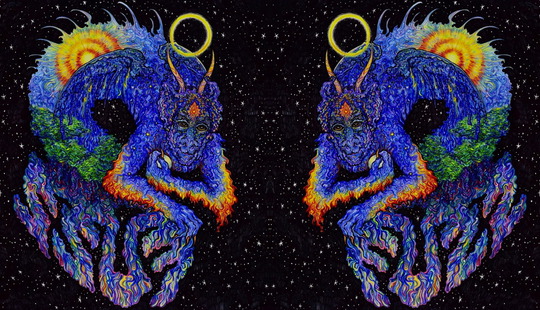 DiS: Ty also appears to be prolific and works a lot, did the guys have time and inclination to feed into the project or were you left to your own devices predominantly?
DiS: Ty also appears to be prolific and works a lot, did the guys have time and inclination to feed into the project or were you left to your own devices predominantly?
TK: Well I had just moved to Brooklyn and they hadn’t seen the real life piece, so we would message each other pretty briefly. Then I moved to London, which is even farther away… thank god for the Internet, but like I said it was basically done before they knew it existed.
Ice, Sea, Dead People, ‘Accept The Mystery’, Lost Toys Records
Ice, Sea, Dead People have been willingly releasing slabs of noise whilst providing interesting ways of presenting their mosh-fodder. They’ve included methods from working with Daniel Eatock and hosting a ‘paint your own’ seven-inch whilst the band played the lead track from said record (‘You Could Be A Model’) on repeat for the whole day, to offering fans the opportunity to create their own backings for the bands video to past single ‘Green Tea’. Whilst the illustrator for the cover of ‘Accept The Mystery’, Rowan M, was unavailable, ISDP’s front man Craig Sharp, a graphic designer himself, answered a few questions on the band’s playfully grotesque artwork.
DiS: Isn’t Rowan the brother of an ex girlfriend? Is that awkward, or nepotism, or fine, or all three?
CS: Yes Rowan is my ex girlfriend's brother and I'd seen his art before, but when I saw the first sketch of the cat I thought it had to go on a record. At this point I didn't know if we were going to release a seven-inch or not so I used it as artwork on a private Soundcloud stream. Which accidentally got briefly auto-tweeted. Rowan saw his work being used and sent me a message that we could use it if we want but he'll do a proper version we could use for the seven-inch sleeve, which is what I would have asked him about later down the line. Rowan really quickly turned around the final art. Prowan, if you will. And here we are!
DiS: What kind of cat is it?
CS: I think it's some sort of mutated cat, I call it Kent.
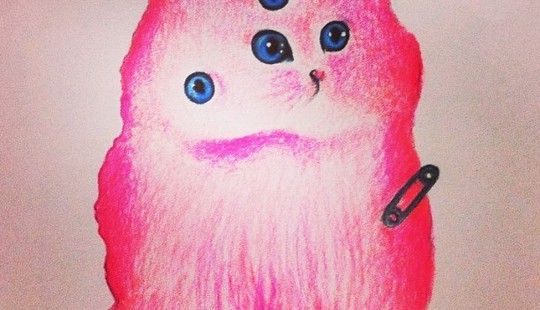
DiS: Seven-inch records are also strange little oddities that exist for their own, or arts, sake, much like Kent. What does Kent reflect about your music?
CS: Well the track is called 'Accept the Mystery' and was partly inspired by the film ‘A Serious Man’. The song title is a quote from perhaps the funniest part where a student bribes his teacher. Jamie (ISDP bassist) and I wrote the lyrics whilst walking home after a house party to be about open endings, absurdism, that sort of stuff.
Weirdly I saw a girl wearing an 'Accept the Mystery' t-shirt about a year ago, so maybe it's a thing? It's kind of annoying. Words seem to lose their meaning when they're put on to t-shirts and totes in a boring serif font way.
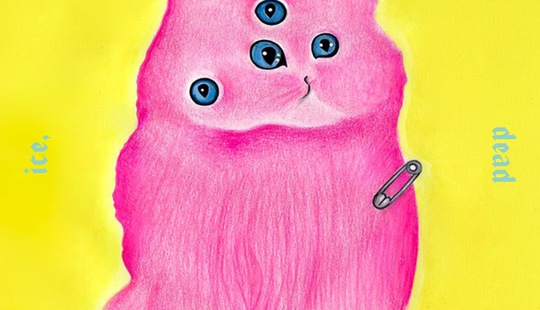
DiS: What can you tell me about how the image was created?
CS: Rowan used pencils and gouache paint. In terms of design, this is pretty boring but we just used the ISDP logo from the ‘If It's Broken, Break It More’ record. I wanted to tie it in with ISDP without taking anything away from the painting.
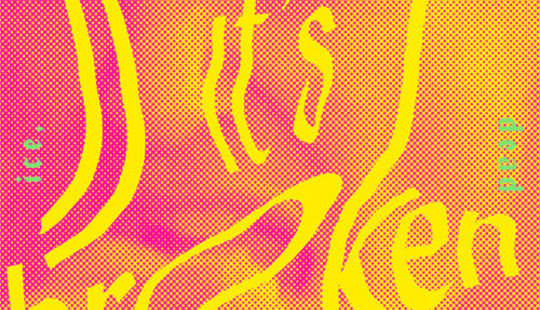
The album art, incidentally, and tenuously, was based on a gig poster I made for a Bedford show we played with Council Tax Band, which was their first show.
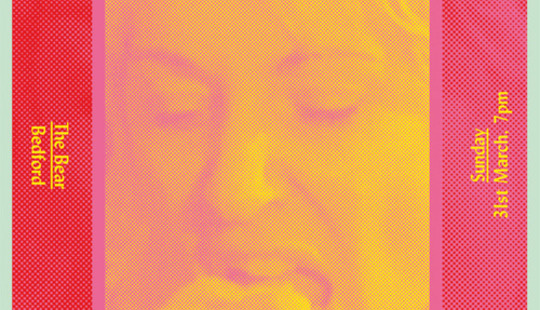
P For Persia/Speak Galactic, ‘Aegis Arctic Alp’ EP, Cupboard Music/Beatabet/Fcuking The Night Records
In true Brighton commune style two bands come together and release a split EP across three independent labels. The EP soars with the intergalactic madness of Sun Ra and Chromehoof, while other moments shift with the magnitude of Mogwai and other post rock heroes. Art student Sophie Bryant-Funnell captures the euphoric madness suitably by giving the EP a space aged mosaic cityscape.
DiS: You’ve a very vivid and identifiable style, have you always been interested in illustration and art?
SB-F: Growing up both my parents were working in design and their studio was in the basement of my house. There was always huge encouragement to be creative and get stuck in with a project, with lots of materials around to do so. I realised quite early on that I was far better at communicating with pictures, than I was with words and whilst at school used any excuse to draw pictures instead of write stuff.
DiS: And music?
SB-F: My mum made me start taking piano lessons when I was about eight and I can remember hating it! Music came really unnaturally to me, but I kept at it and by the time I was in my teens I can remember desperately wanting to be really, really good… Which unfortunately never happened.
When I was about 14 I decided to take up bass, because I thought it was ‘cooler’ than the piano and a few months later I was in a ‘band’. I think we only had two songs, but I used to love making up CD cases and drawing posters for gigs, not that we had many of those either. But I think there is a definite link between art and music; they are both natural and approachable forms of creation and personal expression.
DiS: How did you come to be involved in the EP?
SF-B: I've known P for Persia for a several years, and I have always felt that they have had a strong visual identity. One of their old sets consisted of Dan (vocals) dressing up as a sparkly squid, Luke (drums) and Alex (keys, guitar) then trying to spear him whilst popping balloons filled with glitter over his head. When you watch them live, you can feel yourself being drawn into their crazy and surreal world. It was this that I was trying to encapsulate when creating their EP cover. They've just been working on a music video with Mark Ludgate too, which is full of animation and green screen effects. You'll see what I mean about the visuals in this too, it's pretty crazy.
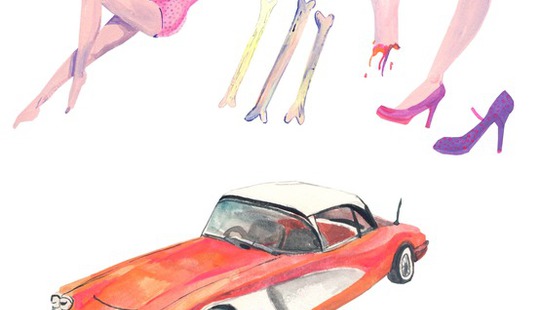
DiS: Your artwork is very bright and eccentric. The EP cover, like the EP itself, it's very psychedelic and acid-trip styled. Space and prog rock seems to scream of drugs and the alteration of perception. How important do you think the notion of perception is, as an artist?
SF-B: I suppose any artists or musician’s work is a reflection or a response to their perception of life and reality, whether they are trying to avoid it or embrace it. I would describe my work as being rather fantastical but also slightly hyper-real. I enjoy creating a sense of otherworldliness, another place that is better and brighter yet also ore dark than our own. The world I'm trying to create embraces it's artificiality and is unashamedly escapist. Kind of like a lucid dream, its a carefully constructed fantasy which uses reality as a framework in which to work- I paint familiar and realistic objects - and then put them together to form a fantasy dreamland.
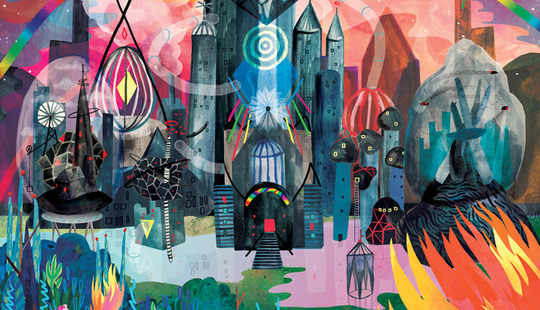
DiS: Your images are also, as you state, very colourful, is colour the main focus of your work?
SF-B: I like to cram as much colour as I possibly can into an image- the brighter, the better. Ironically one of my main inspirations for this album cover was the 1927 film metropolis- whenever I have watched it I have tried to imagine it in Technicolor and I suppose this was me trying to pin some colours down.
DiS: What was the process in putting the cover together, as mentioned you had a very different first attempt, can you take us through the stages and versions put together for the artwork?
SF-B: When I first started off I was going for quite a literal take on story behind the P for Persia songs, the guys sent me this to work with, which led me to my first version;
Our record is a story set in the near future. It's about a guy who meets a girl and they have big eye opening experiences together messing around on drugs. They are careless though and have a car accident whilst messed up, as a result the girl dies and guy loses his arms. In the last part the guy is assigned a household companion robot that's purpose is to care for him and get his life back on track. He initially dislikes the robot, finding it disquieting and invasive. Only he develops a kinship with the machine when he realises the materials that make it work are the same that power his new prosthetic arms, thus he keeps it around till his winter years as a man made replacement for his lost friend.
Everyone decided it was too literal and looked a little too girly and so I simplified it down and just played around with creating a weird, dystopian future- visualising a scene in which the tale could have happened.
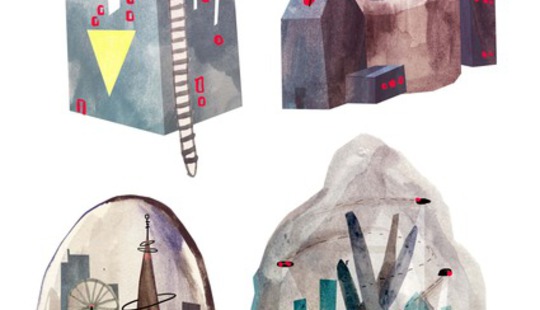
DiS: Was there any post-production work to your images?
SF-B: I create my illustrations by painting each component individually in a sketchbook, then scanning them into Photoshop and cutting them out individually. I then collage them together digitally to create new objects or in this case futuristic buildings.
I then start building an environment to place all the painted pieces in. I think its a bit like creating a stage set, pulling different elements together to create a story and atmosphere, using digital filters and gradients in a similar way to how you would light a stage. I enjoy this way of creating images as it feel it’s quite liberating. Everything can be reversed with a click of the undo button. You don't spend time worrying about messing it all up, with one wrong brushstroke. I don't start out with a plan of how a final image will look. I just plan what components that I want within the image. I only start making decisions about colour, composition and content at the very end just by moving bits and pieces around and seeing where stuff looks best. This makes my work more playful and fun to produce
The Aegis Arctic Alp EP is available now on limited edition dark purple vinyl.




